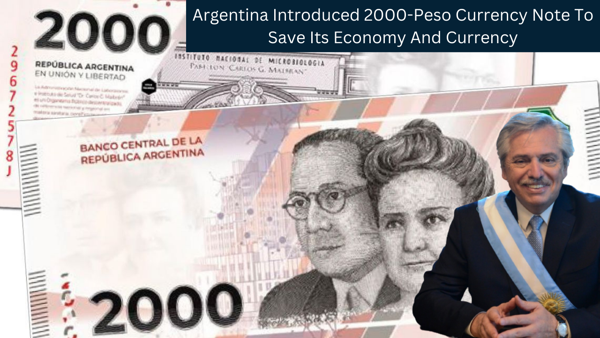
Economy
Economic Crisis: Inflation Hit Argentina Unveils New 2000 Peso Banknote To Save Its Already Ailing Economy
Latin American economy was stable and grew at a rate of 4% last year, despite the Ukraine conflict and the Chinese economic crisis caused by the Covid recovery.
South America's unemployment rate has also decreased significantly, and its service sector, particularly travel, and tourism, has recovered from the pandemic, owing to an increase in foreign tourist footfall in various South American nations, at least through the beginning and middle of 2022.
However, countries began to feel a shortage of goods in the latter part of the year, resulting in civil unrest and political crisis in South American nations. Peru, Brazil, and Argentina are three of the most formidable examples.
Brazil experienced a severe political crisis after Jair Bolsonaro was defeated in an election and Luiz Inácio Lula da Silva was elected president.
In Peru, a political crisis involving an early election, a fuel crisis, and other crises involving other essential goods is still ongoing.
And in Argentina, the economic crisis is still far from over. Argentina is dealing with economic issues on multiple fronts, including currency reserves, inflation, a fuel crisis, and others.
To address these issues, Argentina issued the 2,000 Peso banknote in order to neutralize the venomous effect of inflation.
Argentina's Dilapidated Economy:
Due to the country's economic problems, the Argentine people deposed the previous government and installed leftist president Alberto Fernandez, but he also failed to change the fate of the country's economy despite changing several finance ministers.
Argentina owes over $40 billion to the International Monetary Fund. So far, a population hardened by decades of the economic crisis has refrained from the type of violent street protests that brought down Sri Lanka's insolvent government. However, the most likely future paths all involve significant amounts of pain.
Argentina's annual inflation rate reached its highest level in more than 30 years last year, nearly doubling prices -- its highest official annual figure since 1991 and the hyperinflation experienced in the late 1980s and early 1990s.
Last year, the Argentinian government tried to ease the people's cost of living by raising the interest rate of banks to 75% but that method did not work in favor of the people.
Argentina's inflation is increasing at a rate of 5.1% monthly, which is very concerning for Latin America's second-largest economy. Price increases in December were led by cost increases in restaurants, hotels, alcoholic beverages, and tobacco, which increased by more than 7%.
Argentina's foreign reserves are also depleting at an alarming rate. Because Argentina is not a fuel-producing country, it must import fuel from other countries, and the price of fuel reached a new high following the Ukraine conflict.
In December, International Monetary Fund extended a bailout package of $6 billion but it also failed miserably.
Looking at the unending misery, the Argentinian government last month collaborate with Brazil to lay the foundation of a common currency for all South American nations, the plan has been formalized but it will take some years to be fully implemented.
Apart from that effort now Argentinian government has come up with another ambitious plan and the government launched a new currency note of 2,000-Peso to give relief to the people of Argentina.
Could the 2000-Peso Save Argentina's Economy?
Argentina will issue a new currency note worth $11 in response to the country's soaring inflation - the announcement was made by the country's Central Bank.
Right now, the country's highest bill is 1000-Peso and it is worth $2.70 in the open market and exchanges. Argentina's current currency was introduced in 1992 with a value of one US dollar. But the fixed exchange rate system was abandoned following the country's financial crisis in 2001 and 2002.
Since then, the country's peso has plummeted to the point where it is no longer worth a note and is as cheap as white paper litter on the road.
Why do countries issue higher currency notes during periods of acute inflation?
The introduction of higher denomination currency notes always indicates uncontrolled inflation.
Inflation is the depreciation of money. Money lost its value quickly, and sometimes it crashed like a house of cards. The economy becomes irrelevant on the global stage. Something that happened in Sri Lanka and is now happening in Pakistan.
When a country's currency loses value, the country's commodity prices rise so quickly that an individual's income cannot keep up.
There are two reasons for commodity prices soaring:
1. Reduction in supply
2. Increase in demand
People would prefer larger currency notes to purchase items now that everything is so expensive. It is much easier to purchase a Rs 10,000 item with a few Rs 2000 notes rather than a Rs 100 currency note. This raises the demand for high-value currency notes. When this situation becomes extreme, it is referred to as hyperinflation. In Zimbabwe in 2007-08, this occurred. The highest currency bill in Zimbabwe was a $100 trillion Zimbabwe dollar note.
The market's reaction to the new currency note will be determined by the passage of time; the outcome is yet to be seen.

0 Comments